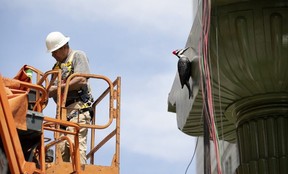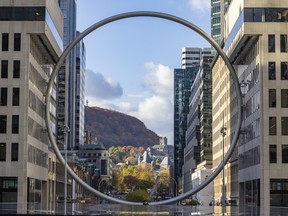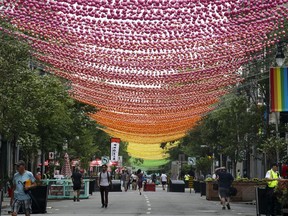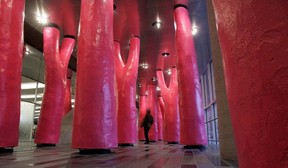Weeks before he died in September, the architect recorded videos shedding light on the birth of some of Montreal’s most iconic public spaces — from Dorchester Square to a kilometre-long canopy of plastic balls in the Village.

Article content
Claude Cormier, who died in September at age 63, left his indelible mark on Montreal, designing some of the city’s most unique public spaces and adding distinctive flourishes to others.
In August, knowing his fight against cancer was coming to an end, the award-winning landscape architect recorded a series of videos reflecting on his life, inspirations and projects.
Advertisement 2
Story continues below
Article content
The result — a 115-minute oral history — premièred at the Canadian Centre for Architecture in June and is now available on YouTube, broken down into 28 short clips.
Cormier’s works were “original, fresh, memorable, painstakingly detailed, and (revelled) in being both highbrow and lowbrow,” said Charles A. Birnbaum, CEO of The Cultural Landscape Foundation, the Washington organization behind the film.
“Heart-shaped pools, dogs spouting water, lipstick-coloured trees — when one is in a Cormier landscape they are treated to individual and collective moments of giddiness and delight that nourish and revivify the human spirit.”
Cormier viewed “history as something not to be looked back on but something to be recontextualized for new audiences — and he did so with originality, meticulous craftsmanship and humour,” Birnbaum said.
“For example, Dorchester Square’s sliced fountain — a stroke of design genius — is now an inextricable part of the park’s identity.”
The film delves into Cormier’s life and work, shedding light on the birth of some of Montreal’s most iconic public spaces, including:
Advertisement 3
Story continues below
Article content

One of Canada’s most impressive public spaces in the 1800s, Dorchester Square in downtown Montreal was a shabby relic when Cormier and his team at CCxA Architectes paysagistes were hired to revive it.
Renovated in phases, the square was reborn over a decade ending in 2019. It retains historical elements such as crisscross paths but pops with unconventional modern twists.
Cormier’s project called for a 10-metre-tall water fountain. A nod to Montreal’s history of park fountains, it would go in an area previously used by cars.
The city threw a wrench in when it decided to save space for tour buses. Officials told Cormier he would have to shrink, move or nix the fountain.
Strategically placed over a column from an underground parking lot below, the fountain’s location couldn’t be moved.
“We (told the city), ‘we can’t make it smaller, we can’t move it, so we’re going to slice it to get the road by,’” Cormier recalls in one of the videos. “As we were presenting it, (city officials) were freaking out.”
He managed to calm their nerves and the half-fountain went ahead, becoming a talking point for passersby.
Article content
Advertisement 4
Story continues below
Article content
“The notion of slicing informs you that this piece is not an authentic 19th-century piece but more of a 21st-century piece,” Cormier told The Gazette in 2019. “It’s a whimsical aspect that makes it of the now.”
It also playfully refers to the fact that the square was once bigger. At one point, a section was paved for parking for the adjacent Dominion Square Building.
A bird added to the fountain’s quirkiness. Affixed to the flat side is a 19-inch aluminum statue of a pileated woodpecker, its flaming red crest contrasting with the green fountain.
Cormier also had to find a creative way to deal with ugly access car ramps for the underground parking lot, which cut part of the square in two. There was no money to move them.
A solution came to him on a trip to Venice — steel-framed footbridges.
The two arched, metal-and-wood bridges give visitors a broad view of the square and have become a magnet for workers and tourists as gathering places for lunch and people-watching.
Advertisement 5
Story continues below
Article content

Amid a $200-million renovation of Place Ville Marie, the complex’s owners thought something was missing from the plaza, a few steps up from ground level.
Cormier said he was tasked with creating a piece that would unify the buildings and the plaza while connecting to McGill College Avenue, a protected visual corridor featuring views of McGill University, the former Royal Victoria Hospital and Mount Royal and its cross.
“‘Do a piece that floats (but) don’t touch the architecture,’” Cormier recalled being told. “‘And don’t touch the ground because it’s under construction.’”
He and his team came up with a 30-metre-diameter stainless steel ring suspended between two PVM buildings. It frames a view of the mountain and contrasts with the angular shapes that dominate the rest of PVM.
Unveiled in 2022, the 23-tonne ring “lightly touches” buildings on either side. It was designed with help from an engineer worked on PVM when it was erected in the 1960s.
“The idea was simple, the site was complex, but the ring now when you look at it, it floats,” Cormier said.
“This new piece of art at PVM does what they wanted — creates something that would bring the whole ‘hood together, simply but powerfully,” Cormier said.
Advertisement 6
Story continues below
Article content
Some Montrealers balked at the cost: $5 million (a mix of city and private money). But it has been a hit with locals and tourists who flock to admire it and capture photos.
Advertisement 7
Story continues below
Article content

Cormier and his team were asked to develop an installation for a one-kilometre stretch of Ste-Catherine St. in the Village. He initially balked at the project and its tiny budget.
A year later, he came up with the idea of stringing about 200,000 pink balls above the street. The initial plan was to buy the balls cheaply from China.
But he was told it had to be made in Quebec, raising the cost. The balls were eventually purchased from a Beauce company for 25 cents each.
A shoestring budget meant the project had to rely on free help. Over four months in 2011, workers from Village stores, restaurants and clubs volunteered to thread the balls onto strings and install the work over Ste-Catherine.
The city initially hated the idea, but it was a hit with merchants and residents. Some tour buses changed their routes so visitors could take in the dramatic cityscape.
The pink balls were up from 2011 to 2016. In 2017, Pink Balls was replaced by 18 Shades of Gay, with balls painted the colours of the Pride flag. The installation was retired in 2019.
Advertisement 8
Story continues below
Article content

When Montreal’s Palais des congrès was being expanded in the 1990s, Cormier was asked to find a way to make the massive concrete building “a little bit more feminine because it (was) too masculine.”
He had a vision for the ground floor: install a series of trunks of trees that were felled after the 1998 ice storm. When that idea fell through for technical reasons, he opted for artificial tree trunks painted bright, lipstick pink.
Quebec government officials were doubtful: “I remember the meeting — not a word, dead silence. They couldn’t deal with it. It was too much.” But the building’s architects loved the concept and pushed it through.
Construction workers on the Old Montreal job site taunted the landscape workers delivering and installing the pink trees, calling them “faggots,” Cormier recalled.
“At the end, when the forest was installed, the faggots became the champions. They got respect from all the other workers because this thing brought some other dimension to a building that was too masculine.”
He said the project, known as Lipstick Forest and completed in 2002, “is a very important beginning of me not being ashamed of being a gay man creating subversive landscapes.”
Advertisement 9
Story continues below
Article content
To watch all the Claude Cormier videos, visit youtube.com/@tclfsteward
Recommended from Editorial
Advertisement 10
Story continues below
Article content
Article content


Comments